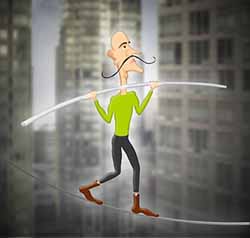Plus Magazine
A sense of balance: solution

Surely a mathematician can help
The key idea needed in order to understand why the tightrope walker carries a long pole to aid balance is moment of inertia. It has nothing to do with centre of gravity. The long pole increases the tightrope walker's moment of inertia by placing mass far away from the body's centre line (moment of inertia has units of mass times the square of distance).
As a result, any small wobbles about the equilibrium position happen more slowly. They have a longer time period of oscillation (the period of small oscillations about a stable equilibrium increases as the square root of the moment of inertia) and the walker has more time to respond and restore the equilibrium.
Compare how easy it is to balance a one metre ruler on your finger compared with a ten centimetre ruler.
Back to Outer space